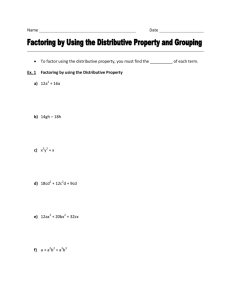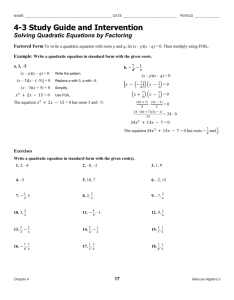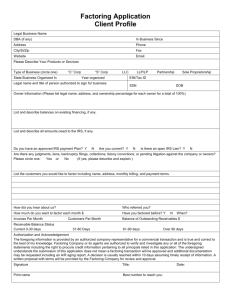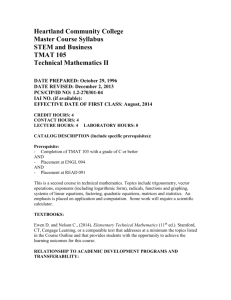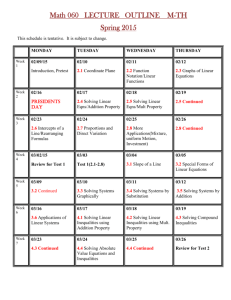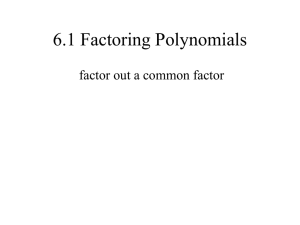Musings on Factoring of Polynomials Bob Rosenbaum
advertisement
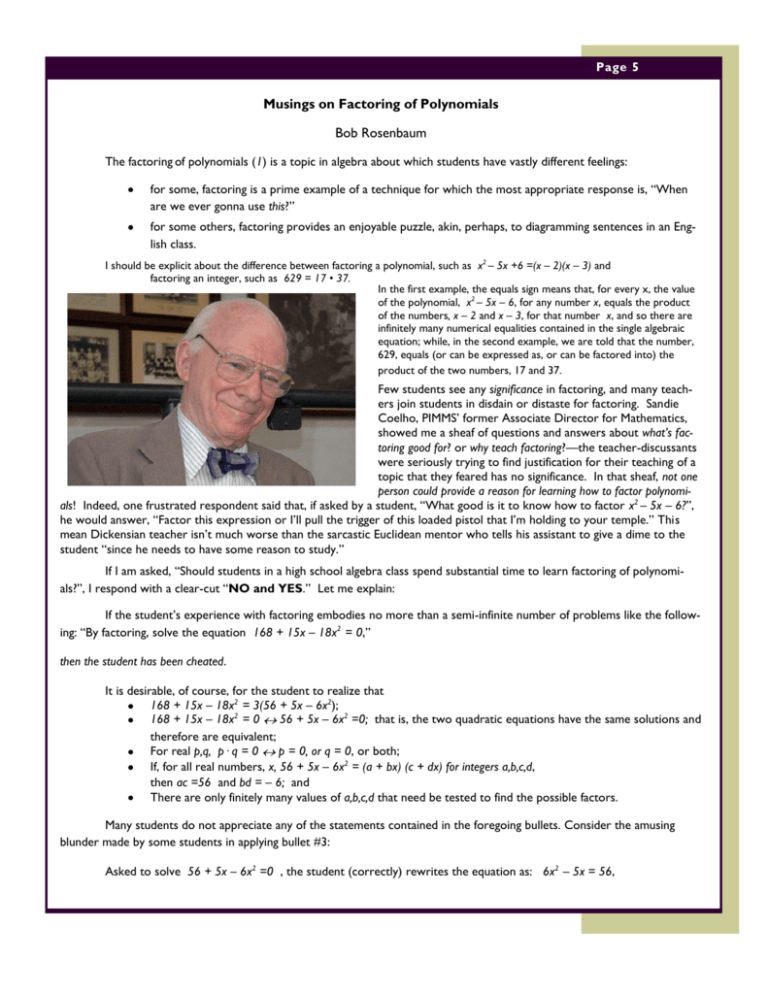
Page 5 Musings on Factoring of Polynomials Bob Rosenbaum The factoring of polynomials (1) is a topic in algebra about which students have vastly different feelings: for some, factoring is a prime example of a technique for which the most appropriate response is, ―When are we ever gonna use this?‖ for some others, factoring provides an enjoyable puzzle, akin, perhaps, to diagramming sentences in an English class. I should be explicit about the difference between factoring a polynomial, such as x2 – 5x +6 =(x – 2)(x – 3) and factoring an integer, such as 629 = 17 • 37. In the first example, the equals sign means that, for every x, the value of the polynomial, x2 – 5x – 6, for any number x, equals the product of the numbers, x – 2 and x – 3, for that number x, and so there are infinitely many numerical equalities contained in the single algebraic equation; while, in the second example, we are told that the number, 629, equals (or can be expressed as, or can be factored into) the product of the two numbers, 17 and 37. Few students see any significance in factoring, and many teachers join students in disdain or distaste for factoring. Sandie Coelho, PIMMS’ former Associate Director for Mathematics, showed me a sheaf of questions and answers about what’s factoring good for? or why teach factoring?—the teacher-discussants were seriously trying to find justification for their teaching of a topic that they feared has no significance. In that sheaf, not one person could provide a reason for learning how to factor polynomials! Indeed, one frustrated respondent said that, if asked by a student, ―What good is it to know how to factor x2 – 5x – 6?‖, he would answer, ―Factor this expression or I’ll pull the trigger of this loaded pistol that I’m holding to your temple.‖ This mean Dickensian teacher isn’t much worse than the sarcastic Euclidean mentor who tells his assistant to give a dime to the student ―since he needs to have some reason to study.‖ If I am asked, ―Should students in a high school algebra class spend substantial time to learn factoring of polynomials?‖, I respond with a clear-cut ―NO and YES.‖ Let me explain: If the student’s experience with factoring embodies no more than a semi-infinite number of problems like the following: ―By factoring, solve the equation 168 + 15x – 18x2 = 0,‖ then the student has been cheated. It is desirable, of course, for the student to realize that 168 + 15x – 18x2 = 3(56 + 5x – 6x2); 168 + 15x – 18x2 = 0 56 + 5x – 6x2 =0; that is, the two quadratic equations have the same solutions and therefore are equivalent; For real p,q, p· q = 0 p = 0, or q = 0, or both; If, for all real numbers, x, 56 + 5x – 6x2 = (a + bx) (c + dx) for integers a,b,c,d, then ac =56 and bd = – 6; and There are only finitely many values of a,b,c,d that need be tested to find the possible factors. Many students do not appreciate any of the statements contained in the foregoing bullets. Consider the amusing blunder made by some students in applying bullet #3: Asked to solve 56 + 5x – 6x2 =0 , the student (correctly) rewrites the equation as: 6x2 – 5x = 56, Page 6 permitting the factorization: x(6x – 5) = 56. Now the student applies a home-grown (and false) generalization of our ―fundamental principle‖(bullet #3) to conclude that x = 56 or 6x – 5 = 56 (!) The student failed to recognize that the statement of bullet #3 is true if and only if the constant is zero. To teach factoring as a method for solving quadratic equations may be considered an exercise in futility, because the factorable quadratic expressions form so insignificant a subset of all quadratic expressions. But, ―completing the square‖ to obtain the ―quadratic formula‖—now there’s something worthwhile! I say this with enthusiasm because the process of completing the square leads to reducing the quadratic equation whose roots we seek to a couple of linear equations whose roots we already know how to find—in analogy with the sort of reduction used by Tartaglia and Ferrari to solve cubic and quartic equations (2). Often the solutions (answers) of a problem are almost unrelated to the value of solving the problem. The important values of solving classroom problems are the procedures (patterns, or sequences of steps) that are recognized as useful also in solving numerous other problems. In response to the query, ―When are we ever gonna use this?‖, the student probably expects an example that seems practical, from his or her point of view, and solving an algebraic equation does not strike the average ninth-grader as a really urgent matter. In calculus, factoring is useful to break a rational fraction expression into partial fractions, permitting us to integrate the original expression and to deal with some infinite series. But, for a high school teacher to appeal to these applications as reasons for learning to factor forces the teacher to say, ―Trust me, you’ll need this sometime in the future‖—a pedagogically weak argument (3). Thus, I say NO! to spending lots of time in elementary and intermediate algebra classes on factoring quadratic expressions in order to solve quadratic equations. On the other hand, I think that it is not only desirable but really pedagogically necessary to work through some factoring to get across the important concepts contained in the five bullets above. This explains part of the reason for the YES in my answer to the factoring question. Now let me strengthen my YES by outlining three problems, not involving the solution of equations, whose solutions require that students have an understanding of factoring and some facility with the process. The first of these problems is appropriate for a first course in algebra, while the second and third may require more mathematical maturity than typical ninth-graders have. Prob. 1 Observe that 1∙3 2∙4 3∙5 4∙6 5∙7 + 1 = 4, + 1 = 9, + 1 = 16, + 1 = 25, + 1 = 36. What pattern do you notice? Express your guess (conjecture) in words. How do you know whether this pattern continues indefinitely? The pattern might be described as follows: The product of two consecutive odd numbers, or of two consecutive even numbers, plus 1, equals a perfect square - the square of the “skipped” number. A direct algebraic argument that this pattern is valid in general follows from letting the first number in the product be called n. It doesn’t matter whether it is even or odd. Then the second number in that product will be n + 2; the product of the two numbers is n(n + 2); and the left hand side of the equations of the problems will be n(n + 2) + 1. But n(n + 2) + 1 = n2 + 2n + 1, which equals (n + 1)2. Page 7 This is clearly the square of (n + 1), the number ―skipped‖ between n and (n + 2). The equality n(n + 2) + 1 = (n + 1)2 is an identity, valid for all integers, n, and thus validates the guess expressed in words above. Prob. 2 (Given to a Middletown, CT sixth-grade class by the cosmopolitan mathematician and educator, W. W. Sawyer, over 50 years ago. The problem also appears as the second exercise in The Theory of Numbers, a text written by the noted American mathematician, Robert D. Carmichael, about 100 years ago.) Observe that 1 ∙ 2 ∙ 3 ∙ 4 + 1 = 25, 2 ∙ 3 ∙ 4 ∙ 5 + 1 = 121, 3 ∙ 4 ∙ 5 ∙ 6 + 1 = 361, and 4 ∙ 5 ∙ 6 ∙ 7 + 1 = 841. What pattern(s) do you notice? Express your guesses (conjectures) in words. A class may propose a number of good conjectures (like ―all the numbers on the right are odd‖); but, if they have had little experience with guessing in mathematics, some students will come up with pretty wild guesses. I have found that, for a sequence like 25, 121, 361, 841, students will, with minimal guidance, often calculate first differences, and even second and third differences—calculations frequently fruitful. Also, in searching for patterns in a sequence like this one, students tend to fixate on the unit’s digit—not a bad thing, either. Let’s set aside some of the guesses, and turn to a more ―interesting‖ guess. Perhaps a class contains a student for whom ―every integer is a personal friend,‖ as Hardy said of Ramanujan, (4), so that the following guess surfaces without much prompting from the teacher: 25, 121, 361, 841 are all perfect squares. Let’s try two more examples for good measure: 5· 6· 7· 8 + 1 = 1681 = (41)2 , and 6· 7· 8· 9 + 1 = 3025 = (55)2. This looks promising, so we formulate the Polya-esque Guess: The product of four consecutive whole numbers, plus 1, is always a perfect square. This is a satisfying observation, but we must remember Polya’s caution, ―Don’t believe your guesses without proof.‖ (5) Here is where algebra and factoring come into play. We formulate our conjecture as follows: n(n + 1)(n + 2)(n + 3) +1 = s2 ?, (i) the question-mark signifying that we don’t yet know whether statement (i) is valid. Page 8 A straightforward approach to validating equation (i) might go as follows: We multiply out the left side of (i), obtaining n(n + 1)(n + 2)(n + 3) + 1 = n4 + 6n3 + 11n2+ 6n+ 1 . (Do this for practice) We ask, ―Are there numbers a,b,c such that n4 + 6n3 + 11n2+ 6n+ 1 = (an2+bn+c) (an2+bn+c) ?‖ Mentally multiplying out the right side, we see that a must be 1 and c must also be 1. So, we ask ― Is there a number, b, such that n4 + 6n3 + 11n2+ 6n + 1 = (n2 + bn + 1) (n2 + bn + 1) ?” A little experimentation shows that this last equation is valid if and only if b = 3; i.e. n4 + 6n3 + 11n2+ 6n + 1 = (n2 + 3n + 1)2 . Hooray! The product of four consecutive whole numbers, plus 1, is always a perfect square! Factoring provided the key! Comments and Queries on the Problems (a) The factored form obtained above helps us to check other conjectures, e.g., that the sequence of unit’s digits in n(n + 1)(n + 2)(n + 3) +1, for n=1, 2, 3, • • • , is 5, 1, 1, 1, 1, 5, • • • , What is the sequence of unit’s digits in n2 + 3n + 1 ? (b) Note that 2 • 3 • 4 • 5 +1=(11)2, and 11=2 • 5+1=3 • 4 – 1 Pattern? Verification? (Based on results we have found above, this one is easy.) Indeed, if we observe that n(n + 3) = n2 + 3n = (n2 + 3n + 1) – 1 , and that (n + 1)(n + 2) = n2 + 3n + 2 = (n2 + 3n + 1) + 1 , then we can conclude that n(n + 1)(n + 2)(n + 3) = [(n2 + 3n + 1) – 1][(n2 + 3n + 1) + 1]= (n2 + 3n + 1)2 – (1)2 , so that n(n + 1)(n + 2)(n + 3) +1 = (n2 + 3n + 1)2 . Is this perhaps an easier way to verify our Polya-esque Guess? (c) Here is an interesting ―closure‖ pattern uniting the results of Prob. 1 and Prob. 2. We illustrate with a numerical example: From the result of Prob. 1, we know that 32 – 1 = 2 • 4, and 42 – 1 = 3 • 5 . From the result of Prob. 2, we know that (3 • 4 – 1)2 – 1 = 2 • 3 • 4 • 5 . Try some other numerical cases, formulate the statement of a pattern, and show that the pattern is valid in general. Page 9 (d) Can you generalize Prob. 2? (This query might be more appropriate for a second course in algebra than for an introductory course in the subject.) What can you say about (3 ½)(4 ½)(5 ½)(6 ½) + 1? Instead of considering four consecutive integers, how about integers that go up by two’s, like 1 • 3 • 5 • 7, or 2 • 4 • 6 • 8 ? If we add 1 to either of these products, we do not obtain a perfect square. Can you find a constant, h , that, added to either of these products, gives a perfect square? If k is a positive integer, can you find a positive integer, l , that makes n(n + k)(n + 2k)(n + 3k) + l = t2 for all n ? Then, what is the value of t in terms of n and k? Prob. 3 Discuss the values of n4 + 4, for n=1, 2, 3, • • • A table of values starts like this: n n4 1 5 2 20 3 85 4 260 5 629 6 1300 7 2405 ••• ••• Here are some conjectures about the numbers in the sequence n4 + 4 for n=1, 2, 3, • • • (a) The numbers oscillate: odd, even, odd, even, • • • (b) The numbers are divisible by 5 if and only if n is not divisible by 5 (c) The numbers are composite (not prime) for n= 2, 3, 4, • • • It looks as though conjecture (b) is valid; and, if so, the values of n4 + 4 are divisible by 5 for n not divisible by 5. Then these values are composite, for n not divisible by 5, except for n = 1 where n4 + 4 = 5 . Now, for n=5, n4 + 4 =629 = 17 • 3 ; for n=10, n4 + 4 =10004 = 22 • 2501 = 22 • 41 • 61 ; and for n=15, n4 + 4 = 50629 =197 • 257. Thus, we have some supporting evidence for conjecture (c), but we have no proof as yet. Moreover, there seems to be an argument that suggests that n4 + 4 may not be composite for all integers n > 1: If we consider a2 – b2 and a2 + b2, we recognize that the first of these expressions is factorable, a2 – b2 =(a – b)(a + b); but we say that the second is not: For a and b arbitrary integers there are no integers, r and s, both larger than 1 and expressible in terms of a and b, such that a2 + b2 = r • s. (6) Now n4 = (n2)2 and 4 = (2)2 so for a = n2 and b = 2, n4 + 4 = a2 + b2 . So, although we seem to have here an argument that n4 + 4 can not be broken up into the product of two factors, the argument is not valid – n2 and 2 are not arbitrary integers. Indeed, Page 10 n4 + 4 = n4 + 4n2 + 4 – 4n2 = (n2 + 2)2 – (2n)2 = (n2 + 2 – 2n)(n2 + 2 + 2n). (This gambit – adding and subtracting the same quantity – is standard in the bag of tricks for factoring.) So, we have broken n4 + 4 into the product of two factors, except that, for n = 1, one of the factors is just 1. In summary, then, I suggest that we should not spend a lot of time in an elementary algebra class on trying to solve polynomial equations by factoring, but that there are reasons for teaching the factoring of polynomials, such as, to drive home some basic mathematical principles, and to provide experience with the notions of prime and composite numbers, and with squares and other powers. Perhaps you have further suggestions. (7) References and Notes (1) The English words, factor and factoring, have various connotations. Ninth-grade students might fruitfully work in groups, with the help of a dictionary, to learn mathematical and non-mathematical examples of the uses of these words. (2) The formulas for the roots of second degree (quadratic), third degree (cubic), and fourth degree (quartic) equations in terms of their coefficients have an interesting history. See, for example, Howard Eves, An Introduction to the History of Mathematics, Revised Edition; Holt, Rinehart and Winston. (3) You may enjoy this eloquent statement with which F.L. Griffin closes his Introduction to Mathematical Analysis: Much of . . . higher mathematics is very abstract. But it is not therefore valueless, even from the standpoint of applications. Several subjects which originally developed in a theoretical way with no thought of a practical application have later been taken over bodily by some practical science, e.g., electrical engineering, crystallography, …. The theoretical mathematics of today may be practical mathematics tomorrow. But this is only one aspect of the matter. The intellectual values obtainable from a contemplation of the power, elegance, and absolute precision of mathematical reasoning, and of the perfect harmony existing among the various branches, are very great indeed. Abstract mathematics is a work of invention—a free creation of the human spirit, as truly a work of art as the Moonlight Sonata or the Sistine Madonna, but on a much vaster scale than the entire library of great symphonies, the whole gallery of famous paintings, or, indeed, the total assemblage of celebrated cathedrals. . . . Men and women who have time to get an understanding of the more advanced branches (of mathematics) find nothing finer and more inspiring than the wonderfully abstruse investigations of pure mathematics—achievements of the reason which far transcend the realms of physical sense, and time and space. (4) The great British mathematician, G.H. Hardy (1877-1947) and the essentially self-taught Indian genius, S. Ramanujan (1887-1920) form a fascinating pair. Something of their work and relationship can be found in the first chapter of Hardy’s Ramanujan: 12 lectures on subjects suggested by his life and work. (5) See, for example, Polya’s film, ―Let us teach guessing.‖ (6) It is useful in many mathematical problems to know about the factorability or non-factorability of (mk – nk) and (mk + nk) . (7) I gratefully acknowledge the mathematical, pedagogical, rhetorical, and editorial contributions to the improvement of this paper of Sandie Coelho, Dan Dolan, Bruce Meserve, Mari Muri, Jim Reid, and Marjorie Rosenbaum.
